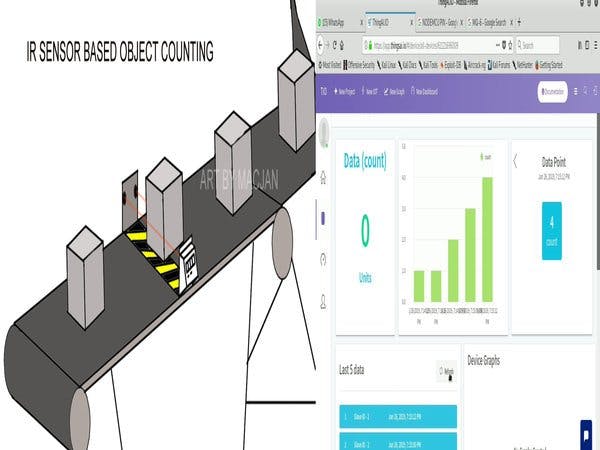An IR sensor is used here as to get the detection of the object by emitting the infrared rays and also by receiving its rays back using the IR detector which comes back from being reflected back from the object.
This sensor module have great adaptive capability of the ambient light, having a pair of infrared transmitter and the receiver tube, the infrared emitting tube to emit a certain frequency, encounters an obstacle detection direction (reflecting surface), infrared reflected back to the receiver tube receiving, after a comparator circuit processing, the green LED lights up, while the signal output will output digital signal (a low-level signal), through the potentiometer knob to adjust the detection distance, the effective distance range 2 ~ 80cm working voltage of 3.3V-5V. The detection range of the sensor can be adjusted by the potentiometer, with little interference, easy to assemble, easy to use features, can be widely used robot obstacle avoidance, obstacle avoidance car assembly line count and black-and-white line tracking and many other occasions.
Features- When the module detects obstacles in front of the signal, the circuit board green indicator light level, while the OUT port continuous output low-level signals, the module detects a distance of 2 ~ 80cm, detection angle 35 °, the detection distance can be potential adjustment with adjustment potentiometer clockwise, the increase in detection distance; counterclockwise adjustment potentiometer, the detection distance decreased.
- The sensor active infrared reflection detection, target reflectivity and shape of the detection distance of the key. The black minimum detection range, white maximum; small area object distance is small, a large area from the large.
- The sensor module output port OUT can be directly connected with the microcontroller IO port can also be driven directly to a 5V relay; Connection: VCC-VCC; GND-GND; OUT-IO
- The comparator using LM393, stable;
- 3-5V DC power supply module can be used. When the power is turned on, the red power LED is lit;
- With the screw holes of 3mm, easy to install;
- Board size: 3.1CM * 1.5CM
- Each module in the delivery has threshold comparator voltage adjustable via potentiometer, special circumstances, please do not adjust the potentiometer.
- VCC external 3.3V-5V voltage (can be directly connected with the a 5V microcontroller and 3.3v microcontroller)
- GND external GND
- OUT board digital output interface (0 and 1)
Here the IR Sensor is used to detect the object as there a program is being continuously running in a loop. So it is fixed with a time period delay it can be change according to the requirement of the counter here it is about 1000 ms means 1 sec. So as the object passes from the front of the sensor it get an object detected and then it counts its value... Let's have a demo look by assuming some assumptions valid.
Similarly this can also be done to make an IR-based counter.
Video Guide

















Comments